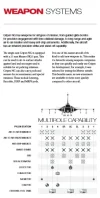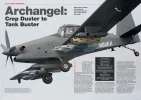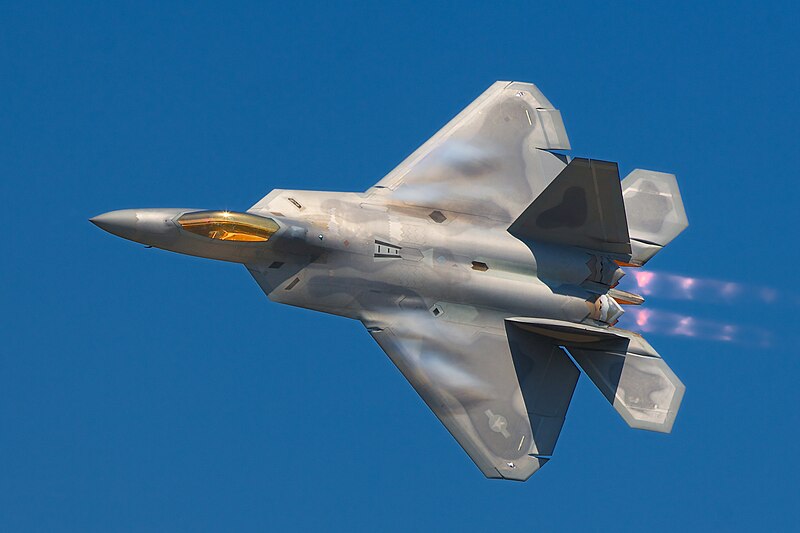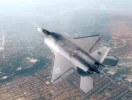Install the app
How to install the app on iOS
Follow along with the video below to see how to install our site as a web app on your home screen.
Note: This feature may not be available in some browsers.
You are using an out of date browser. It may not display this or other websites correctly.
You should upgrade or use an alternative browser.
You should upgrade or use an alternative browser.
Ilmavoimien tulevaisuus
- Viestiketjun aloittaja Museo
- Aloitus PVM
-
- Tagit
- ilmavoimat tulevaisuus
Huhta
Greatest Leader
Typhooniin saa 23 tonnia, mutta niistä 3x1000 on ilmeisesti lisäpolttoainetta (luvusta poistettava myös sisäisen tankin polttoaineen paino). Eli loppuu ripustimet kesken, ei ainakaan ylitä A/A:ssa F-35 kykyä ennen pitkää.
Joo, mutta ajatelkaapa pojat Gripeniä! Siihen saa kuusi (risteily-/)meritorjuntaohjusta (RBS-15)... Painonkin puolesta on mahdollinen konfiguraatio, koska tyhjäpaino on kuulemma 8000 kg ja maksimilentoonlähtöpaino 16 500 kg. Toimintasäde ei kyllä kovin pitkä ole tuollaisella varustuksella. Tuollaisella asekuormalla voi olla, että Gripen tarvitsee sen 10 000 jalan kiitotien, josta Gripen-fanboyt ovat pilkanneet F-35:ttä.


Kuva: Saabin esite
Sillä kuormalla muuttuu Gripen NL:ksi (Next Level).Joo, mutta ajatelkaapa pojat Gripeniä!
Saattaa olla, että oheinen artikkeli on jo pastattu tänne mutta jaan sen nyt kuitenkin. Tämä artikkeli avasi ainakin omat silmät ja sen mistä oikein nykyajan ja tulevaisuuden ilmataistelussa on oikein kyse. Tähän voi vielä pienellä mielikuvituksella lisätä muutakin ilmaan liittyvää tekniikkaa ja isokuva alkaa hahmottumaan.  (Ja sen mitä mahdollisesti RFI on sisältänyt)
(Ja sen mitä mahdollisesti RFI on sisältänyt)
http://foxtrotalpha.jalopnik.com/infrared-search-and-track-systems-and-the-future-of-the-1691441747
 (Ja sen mitä mahdollisesti RFI on sisältänyt)
(Ja sen mitä mahdollisesti RFI on sisältänyt)http://foxtrotalpha.jalopnik.com/infrared-search-and-track-systems-and-the-future-of-the-1691441747
Saattaa olla, että oheinen artikkeli on jo pastattu tänne mutta jaan sen nyt kuitenkin. Tämä artikkeli avasi ainakin omat silmät ja sen mistä oikein nykyajan ja tulevaisuuden ilmataistelussa on oikein kyse. Tähän voi vielä pienellä mielikuvituksella lisätä muutakin ilmaan liittyvää tekniikkaa ja isokuva alkaa hahmottumaan.(Ja sen mitä mahdollisesti RFI on sisältänyt)
http://foxtrotalpha.jalopnik.com/infrared-search-and-track-systems-and-the-future-of-the-1691441747
On postattu, mutta ei missään tapauksessa haittaa. On useammankin postaamisen väärti

Mukava että liityit mukaan keskusteluun.
arcanine98
Kersantti
Typhoonissa ei tietääkseni ole vielä SAR-mapping kykyä kuten meidän Hornetissa ja Typhoon kykenee kantamaan vasta Storm Shadowia ja Paveway Mk IV laserpommeja. Toki homma muuttunee hieman kun P3E-vaiheessa Captor-E tulee käyttöön yhdessä Brimstonen kanssa mutta siihen menee vielä aikaa.
Typhoonissa on kai ollut SAR-moodit ja GMTI jo pitempään. Ensimmäisessä tutkassa eli Captor C:ssä SAR "1 m" resoluutiolla ja nykyisessä CAPTOR M:ssä "0,3 m" resoluutiolla. http://wiki.scramble.nl/index.php/Euroradar_Captor. AESA-tutkissa SAR mapping toimii sitten joustavammin/tarkemmin/nopeammin/tehokkaammin.
Gyllis1
Respected Leader
F-117 oli toki hyvin suppeaan tehtävätyyppiin tarkoitettu kone ja jonkinmoinen uranuurtaja alallaan. Niinhän ne 50-luvun suihkuhävittäjätkin palvelivat vain 5-10 vuotta.
Tähän liittyen hauska anekdootti F-117:n tulikasteesta Bagdadin yllä:
The jet was an ergonomic nightmare as it was originally designed, and the guys who took it to downtown Baghdad on the first night of the war in Jan '91 got to experience some of this. Don't know if I've related this or not before here, but I'll do so only because it's applicable to what I bring up here.
When I was in training for the F-117, one of our civilian instructors....Mr Klaus Klause related a story of how ergonomics slowly but surely came to be for this jet. First night of Desert Storm in '91, he was one of the first wave of F-117s going into Baghdad to hit the command centers located deeper than the radar sites on the border the Army AH-64s had hit at almost the same time. It wasn't really known at that time if stealth technology actually worked, as it had never been tested in real-world combat. The F-117, being slapped together from miscellaneous odds and ends from the A-10 (cockpit), F-15A (gear/components), F-16A (FBW) and F/A-18A (engines), it wasn't very ergonomically friendly in the cockpit in a number of ways. As Klause is getting over Baghdad, the AAA that was filling the air in a general barrage fashion starts immediately shifting in his direction, as if it's tracking him. So he begins to slightly change course (which is not recommended for a number of reasons), and the AAA keeps tracking him, with airbursts going off all around him. Finally he really starts maneuvering (to hell with not recommended), thinking "this stealth crap is bullshat, Lockheed the lowest bidder" and other choice thoughts, finds his target, drops his bombs and gets the literal hell out of there.
Crossing outbound to friendly territory to the south, he's getting his systems back on-line, Fencing out, and notices that his position (nav) lights are still on and thats how the gunners were seeing him: visually. Back then in the 117, there were 5 different switches controlling 5 different external lighting systems, located in 5 completely separate places in the cockpit. On fence-in, he'd forgotten the position lights switch. A few years later, the USAF installed a single "all external lights- extinguish" switch on the left wall panel for ergonomic sake, aptly named the "Klaus switch".
Kertojana F-16.netissä vaikuttava entinen F-117 pilotti
Muoks. Omituisena kuriositeettina, kaikki pommituslennot suoritettiin etukäteen suunniteltuja reittejä pitkin. Nykyisin paljon mainostettua tilannekuvaa ei lentäjällä ollut oikeastaan ollenkaan, koneessa ei ollut esimerkiksi minkäänlaista tutkavaroitinta. Tämän takia tuolta etukäteen suunniteltulta reitiltä poikkeamista pidettiin hyvin huonona ideana.
Viimeksi muokattu:
Einomies1
Respected Leader
Höpöjä! Mikäli BAE:n omiin sivuihin on uskominen, P1E incrementissä 2015 vasta Typhoon sai ensimmäisen ilmasta-maahan kyvyn joka oli Paveway IV pommi+laserosoitinpodi.http://www.baesystems.com/en-uk/product/typhoonTyphoonissa on kai ollut SAR-moodit ja GMTI jo pitempään. Ensimmäisessä tutkassa eli Captor C:ssä SAR "1 m" resoluutiolla ja nykyisessä CAPTOR M:ssä "0,3 m" resoluutiolla. http://wiki.scramble.nl/index.php/Euroradar_Captor. AESA-tutkissa SAR mapping toimii sitten joustavammin/tarkemmin/nopeammin/tehokkaammin.
Tranche 1 ja vielä 2 koneet oli ilmasta-maahan tehtävien ulkopuolella tai hyvin heikoilla Libyan kriisin aikana 2011 ja RAF joutui toimimaan vanhoilla Tornado Gr.4 koneillaan. Typhoonit vastasivat vain ilmasuojasta/valvonnasta kuten Gripenkin. Sensijaan Rafalet keräsivät runsaasti kannuksia jo tuolloin Ranskan omassa "Operation Harmattanissa", heti kriisin alussa toimien molemmissa rooleissa ilman mitään ongelmia.
Typhoon saa vasta E-Scanin tullessa "full-modet" joten olen melko varma että mitään SAR-moodeja koneessa ei ole vieläkään.
Tämä sivusto ilmoitti näin: The ECR-90 radar provides air-to-air and air-to-surface coverage. Its air-to-air radar features include search modes, lock-follow modes, and air combat acquisition modes. its air-to-surface radar features include search modes, track modes, and air-to-surface ranging and terrain avoidance modes. http://www.defencetalk.com/ecr-90-captor-radar-rides-on-eurofighter-typhoons-success-22911/
Tämäkin tieto on vuodelta 2009 mutta Wikiin verrattuna siinä puhutaan noista moodeista vähän tarkemmin. Tuossa Wiki-linkissäsi muuten SAR- hyperlinkki viittasi "Search And Rescue"-toimintaan
 . Kannattaisi katsoa mitä lähteitä käyttää, Wikistä en ole juuri koskaan päässyt lähdesivustolle tai sitten tieto on ollut täysin vanhentunutta.
. Kannattaisi katsoa mitä lähteitä käyttää, Wikistä en ole juuri koskaan päässyt lähdesivustolle tai sitten tieto on ollut täysin vanhentunutta.arcanine98
Kersantti
Höpöjä! Mikäli BAE:n omiin sivuihin on uskominen, P1E incrementissä 2015 vasta Typhoon sai ensimmäisen ilmasta-maahan kyvyn joka oli Paveway IV pommi+laserosoitinpodi.http://www.baesystems.com/en-uk/product/typhoon
Tranche 1 ja vielä 2 koneet oli ilmasta-maahan tehtävien ulkopuolella tai hyvin heikoilla Libyan kriisin aikana 2011 ja RAF joutui toimimaan vanhoilla Tornado Gr.4 koneillaan. Typhoonit vastasivat vain ilmasuojasta/valvonnasta kuten Gripenkin. Sensijaan Rafalet keräsivät runsaasti kannuksia jo tuolloin Ranskan omassa "Operation Harmattanissa", heti kriisin alussa toimien molemmissa rooleissa ilman mitään ongelmia.
Typhoon saa vasta E-Scanin tullessa "full-modet" joten olen melko varma että mitään SAR-moodeja koneessa ei ole vieläkään.
Tämä sivusto ilmoitti näin: The ECR-90 radar provides air-to-air and air-to-surface coverage. Its air-to-air radar features include search modes, lock-follow modes, and air combat acquisition modes. its air-to-surface radar features include search modes, track modes, and air-to-surface ranging and terrain avoidance modes. http://www.defencetalk.com/ecr-90-captor-radar-rides-on-eurofighter-typhoons-success-22911/
Tämäkin tieto on vuodelta 2009 mutta Wikiin verrattuna siinä puhutaan noista moodeista vähän tarkemmin. Tuossa Wiki-linkissäsi muuten SAR- hyperlinkki viittasi "Search And Rescue"-toimintaan. Kannattaisi katsoa mitä lähteitä käyttää, Wikistä en ole juuri koskaan päässyt lähdesivustolle tai sitten tieto on ollut täysin vanhentunutta.
En kirjoittanut mitään "höpöjä", vaan tarkoitukseni oli vain korjata tuo asiavirhe SAR-moodien osalta. Katsoisitko noista SAR-moodeista vaikka ao. artikkeliin http://www.aviationtoday.com/2003/06/01/typhoon-europes-finest/ tai jos saksa taipuu, niin saksankielisen Wikipedian CAPTOR-artikkelin https://de.wikipedia.org/wiki/EuroRADAR_CAPTOR. Voisinko pyytää sinua myös katsomaan sen Scramblen Wikin linkin SAR-lyhenteestä hieman tarkemmin, saattaa yllättää
 . Ja nuo linkkaamasi valmistajan sivutkin kannattaa katsoa vielä ajatuksella, niissä siis ei sanota että "P1E incrementissä 2015 vasta Typhoon sai ensimmäisen ilmasta-maahan kyvyn", vaan että silloin Typhooniin lisättiin Paweway IV (pienempinumeroiset Pawewayt olivat jo T1 Block 5:ssä). Alla tarkemmin:
. Ja nuo linkkaamasi valmistajan sivutkin kannattaa katsoa vielä ajatuksella, niissä siis ei sanota että "P1E incrementissä 2015 vasta Typhoon sai ensimmäisen ilmasta-maahan kyvyn", vaan että silloin Typhooniin lisättiin Paweway IV (pienempinumeroiset Pawewayt olivat jo T1 Block 5:ssä). Alla tarkemmin:Aviation Today (2003):
Sensor Package
The European fighter has a sensor package that allows a rapid swing between the air-superiority and air-to-ground roles. Its ECR-90 Captor radar, developed by the Euroradar consortium–comprising BAE Systems in the UK, EADS in Germany, FIAR in Italy, and INDRA in Spain–is considered the jewel in the Eurofighter sensor crown. [...]
Air-to-surface modes include beam mapping, sea and surface search, ground moving target indication (GMTI), spot mapping and surface ranging. A synthetic aperture radar (SAR) mode presents ground objects in high definition–to about 1 meter (3.3 feet) in Tranche (or Block) 1 Eurofighter deliveries, improving to a third of a meter (1 foot) in Tranche 2 aircraft. The Captor system can automatically select the modes, or the pilot can do so manually, using the HOTAS control.
Wikipedia:
Das CAPTOR-C (früher als ECR-90C bezeichnet) ist das Serienradar der Tranche 1 Flugzeuge. Die Rechenleistung des Radars liegt bei drei Milliarden Instruktionen pro Sekunde. Die Software beinhaltet 1,2 Millionen Zeilen Code. Im Track-while-Scan-Modus liegt die Ortungsreichweite für ein Jagdflugzeug bei etwa 185 km, es können bis zu 20 Ziele verfolgt und 6 gleichzeitig beschossen werden. Im Synthetic-Aperture-Radar-Modus kartografiert das Radar das Gelände mit einer Auflösung von 1 m. Das erste Softwareupdate R2P stand ab 2012 zur Verfügung, das Softwareupdate R2Q ab Anfang 2013.
Da die Elektronik des CAPTOR-C obsolet geworden war, wurden für die Tranche 2 Modernisierungsmaßnahmen eingeleitet. Dazu zählen neue Hardware mit modernen PowerPC-Prozessoren und ein neuer Missionscomputer mit höherer Rechenleistung. Durch diese Kampfwertsteigerung konnten die EloGM-Fähigkeiten verbessert werden, die Auflösung im SAR-Modus erhöhte sich auf 0,3 m. Das CAPTOR-D verfügt über die vollen Luft-Boden-Eigenschaften (siehe oben), eine Nachrüstung von AESA-Technologie ist möglich. Das Radar wird auch als CAPTOR-M (“M” für mechanisch) bezeichnet. Das erste Softwareupdate T2P stand ab 2012 zur Verfügung, das Softwareupdate T2Q ab Anfang 2013
Tuo mitä kirjoitit siitä, että valmistajan sivuilla sanottaisiin, että vasta P1E-päivityksessä Typhoon olisi vasta saanut ilmasta maahan -kyvyn vaatii myös pientä tarkennusta. Valmistajan sivuilla ei sanota, että ilmasta maahan -ominaisuudet olisivat tulleet P1E-päivityksessä, vaan siellä sanotaan, että tuolloin Typhooniin tuli: "Enhanced Air-to-Surface capability" ja "Typhoon’s Phase 1 Enhancement (P1E) upgrades, delivered in 2015, meant the platform became a high-end multi-role weapon system, with Air to Air capability including ASRAAM and AMRAAM weapons and the integration of Paveway IV for precision Air to Surface operations.". Eli P1E-päivityksessä Typhooniin siis lisättiin laser-/GPS-/inertiaohjattu Paveway IV (ynnä muuta), mutta yksinkertaisemmat Pawewayt tulivat jo Tranche 1 Block 5 -versiossa aiemmin:
Nuo "Tranche" ja "Block" ovat siis eri tuotantoversiota ja P1E, P2E jne. ovat "Phase X Enhancement" -päivityspaketteja. Tuo Typhoonin versioiden/päivitysten nimeäminen on aivan kamala viidakko, mutta tämä ao. ehkä hieman selventää:Tranche 1 Block 5
Introduced 2007, combining existing air-to-air role with 'austere'air-to-ground capabilities, RAF designation Typhoon FGR4. Full performance envelope and air-to-ground munitions handling, full autopilot and DVI, improved GPS, Captor-C radar with initial air-to-ground modes, full DASS including LWR, automated chaff/flare dispenser and Sky Buzzer TRD (Germany only), initial Thales PIRATE capability, full sensor fusion. The RAF received an Austere Package with GBU-48 Enhanced Paveway II (for the RAF), GBU-10 Paveway I and GBU-16 Paveway II (for the other nations). Laser designation provided by a third party (either a land-based designator or a pod installed on another aircraft, much like the Tornado GR1 in the Gulf War. Many Block 1 aircraft were upgraded directly to Block 5 via a combined R1/R2 upgrade. Block 5A aircraft were delivered to Austria and later upgraded to Block 5B configuration.
Identification of Typhoon delivery standards and upgrades can be quite confusing. Here's a quick guide:
- Tranche: Order for a specific number of aircraft for delivery at defined time scales. Production is divided into three tranches.
- Batch: Tranches are divided up into Batches, to better manage production Blocks
- Blocks: Batches are diveded into Blocks, the smallest production break down, each block has a baseline PSC
- Production System Configuration (PSC): describes the cleared aircraft configuration with clearance for specific LRI hardware and software part number; the PSC identifier will change every time an aircraft receives new hardware or software, e.g. new release op UPSP software
- Production Software Package: software standards, split into Avioncs PSP (APSP), Flight PSP (FPSP) & Utility PSP (UPSP), UCS and AVS. There are also different releases of the APSP, UPSP and FPSP softwares associated with each PSC
- Service Release Package: defines overall level of capability and clearances. The SRPs are related to PSCs (not the other way round), but there might nontheless be different PSCs for one.
- Drops: Drops adds functionalities and capabilities to Tranche 1 aircraft via software updates.
- Enhancement Package: adds functionalities and capabilities to Tranche 2/3 aircraft
Vielä kaikella ystävällisyydellä tuosta Scramblen wikistä sellainen yksityiskohta, että SAR-linkki siellä EI viittaa Search And Rescue -toimintaan kuten kirjoitit, vaan lyhennesivustolle, jossa SAR:lle on kaksi lyhennettä päällekäin "Search and Rescue" ja "Synthetic Aperture Radar". Et varmaaankaan huomannut tuota alempaa
 .
. http://wiki.scramble.nl/index.php/General_Abbreviations#S
SAR Search and Rescue
SAR Synthetic Aperture Radar
Tarkoitukseni oli siis vain korjata tuo asiavirhe SAR-moodien osalta. Pahoittelen, jos laittamani korjaus vaikutti jotenkin loukkaavalta. Tuo mitä kirjoitit Rafalen hienoista suorituksista Libyassa 2011 on hyvin totta ja muistan kyllä, kun siitä oli aikoinaan juttua. Kiva kun olet aiheesta kiinnostunut, samaa aihetta tässä mietiskellään.
ps. toivottavasti muuten onnistuin käyttämään noita foorumin linkitys- ja lainaustoimintoja oikein.
Gyllis1
Respected Leader
Onko veljille tällainen kikotin tuttu?
http://www.iomax.net/archangel/
Iomax Archangel, jollain oudolla tavalla seksikäs peli, tulee hieman sellainen Mad Max -fiilis.

http://www.iomax.net/archangel/
Iomax Archangel, jollain oudolla tavalla seksikäs peli, tulee hieman sellainen Mad Max -fiilis.

Sukunäkö on ilmeinen. IL-2 Sturmovik


Huhta
Greatest Leader
Turkkilainen Tusas Aerospace Industries (TAI) ja BAE systems ovat julkaisseet kuvan yhteistyönsä hedelmästä, TF-X hävittäjästä:
Katso liite: 14477
Näyttää F-35:ltä johon on ängetty toinen moottori ja Raptorista varastetut korkeusvakaajat...
Oikeastaan tuo näyttää mielestäni enemmän nimenomaan siltä Raptorilta. Ohjaamosta on hyvä näkyvyys ja runko on kaksimoottorisena aika samanlainen kuin Raptorissa. Lähinnä nokkaa on vähän typistetty, kuten F-35:ssä.

Gyllis1
Respected Leader
Taitaa olla tuo siiven muoto, joka itselleni tuottaa ne F-35 vibatOikeastaan tuo näyttää mielestäni enemmän nimenomaan siltä Raptorilta. Ohjaamosta on hyvä näkyvyys ja runko on kaksimoottorisena aika samanlainen kuin Raptorissa. Lähinnä nokkaa on vähän typistetty, kuten F-35:ssä.

Einomies1
Respected Leader
No nyt on asiaa! Kannattaa laittaa ne linkit oikein ja lopettaa sen läpipaskan Wikin lainaaminen. Jos olisit heti pistänyt kunnolliset lähteet niin ei olisi tarvinnut edes kommentoida koko asiaa!En kirjoittanut mitään "höpöjä", vaan tarkoitukseni oli vain korjata tuo asiavirhe SAR-moodien osalta. Katsoisitko noista SAR-moodeista vaikka ao. artikkeliin http://www.aviationtoday.com/2003/06/01/typhoon-europes-finest/ tai jos saksa taipuu, niin saksankielisen Wikipedian CAPTOR-artikkelin https://de.wikipedia.org/wiki/EuroRADAR_CAPTOR. Voisinko pyytää sinua myös katsomaan sen Scramblen Wikin linkin SAR-lyhenteestä hieman tarkemmin, saattaa yllättää. Ja nuo linkkaamasi valmistajan sivutkin kannattaa katsoa vielä ajatuksella, niissä siis ei sanota että "P1E incrementissä 2015 vasta Typhoon sai ensimmäisen ilmasta-maahan kyvyn", vaan että silloin Typhooniin lisättiin Paweway IV (pienempinumeroiset Pawewayt olivat jo T1 Block 5:ssä). Alla tarkemmin:
Aviation Today (2003):
Wikipedia:
Tuo mitä kirjoitit siitä, että valmistajan sivuilla sanottaisiin, että vasta P1E-päivityksessä Typhoon olisi vasta saanut ilmasta maahan -kyvyn vaatii myös pientä tarkennusta. Valmistajan sivuilla ei sanota, että ilmasta maahan -ominaisuudet olisivat tulleet P1E-päivityksessä, vaan siellä sanotaan, että tuolloin Typhooniin tuli: "Enhanced Air-to-Surface capability" ja "Typhoon’s Phase 1 Enhancement (P1E) upgrades, delivered in 2015, meant the platform became a high-end multi-role weapon system, with Air to Air capability including ASRAAM and AMRAAM weapons and the integration of Paveway IV for precision Air to Surface operations.". Eli P1E-päivityksessä Typhooniin siis lisättiin laser-/GPS-/inertiaohjattu Paveway IV (ynnä muuta), mutta yksinkertaisemmat Pawewayt tulivat jo Tranche 1 Block 5 -versiossa aiemmin:
Nuo "Tranche" ja "Block" ovat siis eri tuotantoversiota ja P1E, P2E jne. ovat "Phase X Enhancement" -päivityspaketteja. Tuo Typhoonin versioiden/päivitysten nimeäminen on aivan kamala viidakko, mutta tämä ao. ehkä hieman selventää:
Vielä kaikella ystävällisyydellä tuosta Scramblen wikistä sellainen yksityiskohta, että SAR-linkki siellä EI viittaa Search And Rescue -toimintaan kuten kirjoitit, vaan lyhennesivustolle, jossa SAR:lle on kaksi lyhennettä päällekäin "Search and Rescue" ja "Synthetic Aperture Radar". Et varmaaankaan huomannut tuota alempaa.
http://wiki.scramble.nl/index.php/General_Abbreviations#S
Tarkoitukseni oli siis vain korjata tuo asiavirhe SAR-moodien osalta. Pahoittelen, jos laittamani korjaus vaikutti jotenkin loukkaavalta. Tuo mitä kirjoitit Rafalen hienoista suorituksista Libyassa 2011 on hyvin totta ja muistan kyllä, kun siitä oli aikoinaan juttua. Kiva kun olet aiheesta kiinnostunut, samaa aihetta tässä mietiskellään.
ps. toivottavasti muuten onnistuin käyttämään noita foorumin linkitys- ja lainaustoimintoja oikein.
Olin siis väärässä....
arcanine98
Kersantti
No nyt on asiaa! Kannattaa laittaa ne linkit oikein ja lopettaa sen läpipaskan Wikin lainaaminen. Jos olisit heti pistänyt kunnolliset lähteet niin ei olisi tarvinnut edes kommentoida koko asiaa!
Olin siis väärässä....
Joo, lähteiden kanssa saa kyllä olla tarkkana. Valmistajien sivuilla on usein harmillisen vähän tarkkaa tietoa koneista. Tällainen sotilasilmailusta kiinnostunut haluaisi tietää enemmänkin kuin että koneen varustukseen kuuluu moottori, peräsin ja penkki

Raveni
Greatest Leader
Tuollaisellekin löytyy varmasti oma lokeronsa. Pari tuommoista rajalle...Onko veljille tällainen kikotin tuttu?
http://www.iomax.net/archangel/
Iomax Archangel, jollain oudolla tavalla seksikäs peli, tulee hieman sellainen Mad Max -fiilis.
Katso liite: 14474

En löytänyt jos tämä on linkitetty tänne aikaisemminkin, mutta on niin hyvä kirjoitus ohjusten kantomatkoista että kestää kertaamisenkin:
http://www.f-16.net/forum/viewtopic.php?p=278268&sid=3dc31c414b01f832bb0b36338b990fbf#p278268
http://www.f-16.net/forum/viewtopic.php?p=278268&sid=3dc31c414b01f832bb0b36338b990fbf#p278268
[email protected] kirjoitti:A/A missile ranges are very complex issue and depend a great deal about engagement geometry, target altitude, launch altitude, target speed, launch speed and several other things.
For example we have a generic A/A missile with max flight range of 100km when launched at near Mach 1 at above 30,000ft. Most such missiles have a rocket engine that provides thrust for about 10 seconds and have a top speed of Mach 4. They also need a few seconds to reach that top speed and then after very short sustained thrust/speed period start to slow down. Having lofted profile provides additional range due to higher altitudes having lower air resistance and thus deceleration is slower. Of course higher altitude also provides potential energy which can be transformed to kinetic energy (altitude to speed) to some extent. If we do some very rough (there might well be errors here) calculations, we see that at at launch the missile speed is Mach 1 at high altitude. Let's say it takes 4 seconds to achieve Mach 4 and that is sustained for 6 seconds. So the missile will travel about 12 km before it starts to slow down. At max flight range the missile will become subsonic and will quickly stall as it will not have enough speed to maintain controlled flight. So if we assume the deceleration is linear (which it isn't, but that gets complicated quickly), the missile would slow down to Mach 3 about 40 km from launch point and to Mach 2 about 70 km from launch point. Of course this assumes the best possible flight profile as any maneuvering by the missile will eat speed and thus range quickly. Of course it also shows that 40 km away the missile will have only about half the kinetic energy it has when the rocket stops burning. At 70 km away the kinetic energy is 4 times smaller. This means the missile will have far less ability to maneuver to catch the target. For example the published range figures for some surface to air missiles indicate that their effective range against maneuvering fighter targets is less than half the range they can catch slow and non-maneuvering targets. Of course when launched at lower altitude the missile has to overcome much higher air resistance and the top speed will be lower and deceleration of the missile much higher. The effective range can be several times smaller than the effective range during high altitude launch.
Of course it's also easy to calculate what the max theoretical ranges are for receding but non-maneuvering targets. Against target flying at Mach 0.5 the effective range with the above missile would be less than 80 km. Against target flying at Mach 1.0 it would be less than 60 km. Against target flying at Mach 2, it would be less than 30 km. Of course if the target maneuvers even slightly, those figures start falling rapidly. Same is true if the target is higher than the shooter.
Of course the max range figures can also be for a max launch range against incoming non-maneuvering target. In that case the missile with 100 km max range might well have only 50-60 km flight range. That means the effective range against bypassing target might be only about 30-40 km and against receding fighter target only about 20-30km. Against low altitude fast receding target which changes direction, the max range might be less than 5 km. So a 100 km missile can't suddenly catch a target the pilot can see with his eyes. Max range figures are pretty meaningless unless specific launch conditions have also been expressed.
Sweden touts 'strategic depth' concept with Finland
http://www.janes.com/article/70187/sweden-touts-strategic-depth-concept-with-finland
http://www.janes.com/article/70187/sweden-touts-strategic-depth-concept-with-finland
The Swedish Air Force (SwAF) has drawn up a concept of 'strategic depth' that would enable Finland to use its bases should that country have to withdraw its forces in the face of an invasion by Russia.
Briefed to reporters in Stockholm on 8 May, the concept is part of a wider bilateral defence cooperation initiative that has been created under the auspices of the newly formed Nordic Defence Cooperation (NORDEFCO) organisation.
"As a small country allied cooperation is vital to us, that's for sure, so we are working very hard to keep the level of cooperation as high as possible and with as many as possible, including with the UN, the EU, and NATO," Colonel Magnus Liljegren from the SwAF headquarters said, adding, "The other organisation is NORDEFCO with the other Nordic countries, and we have been working with this for a couple of years."
As noted by Col Liljegren, Sweden's chief effort within NORDEFCO is in enhancing cooperation its neighbour, Finland. "The focus for us is in enhancing cooperation with Finland, and this is up to the highest levels [of the Swedish government]. Finland is absolutely our top priority partner right now. We have a lot in common, but we also have to bear in mind that Finland is in a different position to us geographically with a border [with Russia] and historically [having fought against Russia]. Finland is a partner that we think can give us a lot, and they are looking to us in order to increase their operational depth. If they need to withdraw they can move into our country and use our bases, so the more we can work together in a flexible way the better it is," the colonel said.
Examples where cooperation between Sweden and Finland have already increased defence cooperation include the field of secure communications; the use of alternate landing bases in each other's country, and with each flying in the other's airspace on a daily basis; air surveillance cooperation; and also with operational planning.

